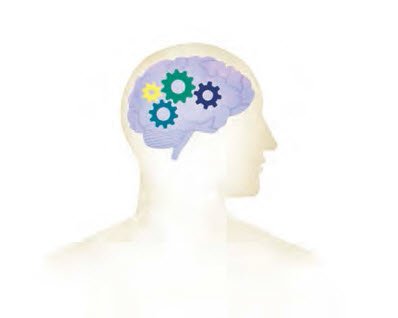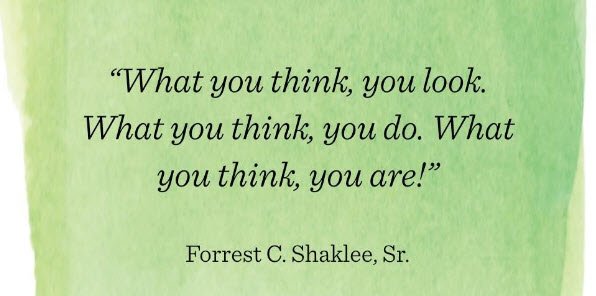What you think, you are
Those words are part of one of my favorite quotes, and, I believe, 5 very powerful words.

Just as important is the fact that: what you think affects your health.
Do you struggle with stress, negative thoughts, anger, or bad moods?
We all have experienced stress and some of us definitely do have more of it in their lives, sometimes for a little while and sometimes it goes on too long.
Have you ever just woke up on the wrong side of the bed? That can almost ruin the day for you. Some people struggle with those kinds of thoughts every day.
We’re not trying to discount anybody’s feelings and know that they are real and can be a struggle, but there is still this knowledge that we can have the power of what to personally think about anything and everything.

Will you go POSITIVE or will you go NEGATIVE with your thoughts?
There is definitely a difference.
Do your thoughts affect your health?
Your mind is an integral part of your overall health. Stress, anxiety, and even negative thoughts threaten your health because they have an effect inside your body.
How Do We Live Younger Longer?
We use a simple anti-aging plan in our quest to live younger longer – meaning to stay healthy and strong and energized as we get each year older. One of the ways we do that is to focus on three areas of our life where we can make simple choices to live healthier: Mind, Body (physical movement), and Nutrition.
It doesn’t require a lot of time to live an anti-aging plan. It is just a matter of getting an easy plan together,and then just following that plan as much as you can in your daily life.
And guess what? It makes a difference!
Affiliate Disclaimer: This site contains affiliate links, which means we receive compensation, at no extra cost to you, if you make a purchase using the links provided. We appreciate your support so much!
This is the first in a series of 3 articles sharing what we do in each area. We start with the Mind.
If you research ‘mind and health’ you’re going to see an abundance of information linking the health of your mind to your physical health.
The quote from Harvard Health is an example.
“Your mood and your mental health affect every aspect of your life, from how you feel about yourself to your relationships with others and your physical health. There’s a strong link between good mental health and good physical health, and vice versa… digestive disorders, trouble sleeping, lack of energy, heart disease, and other health issues.
Harvard Health
Mindset
We begin with the MIND because many people don’t understand just how important your brain is to your health. And exactly how you can train your brain to make a change that you need to make to get healthier.
Each of the three areas – mind, body and nutrition – are complex subjects that can be explored in depth. Our goal for this series is to break them down into simple, easy ways to help you get and stay healthy.
When you think about mind or brain health, you can go in different directions such as mindset, mental health, and brain illnesses. Again, this series is focused on wellness and primarily targets staying well, and helping to improve issues that are keeping you from feeling energized and healthy.
For many of us, we get in our own way in terms of our thinking. And the good news is that our thinking is fixable!

Stress can be anywhere: work, school, at home, while driving or in traffic, while shopping or rushing around.
Stress can lead to anxiety or negative thoughts.
Many people go about their day in a kind of auto zone. And for some they are in a stress filled or even angry zone.
Maybe most days and weeks and years are the same for you and you aren’t really liking your life.
Maybe you don’t think you have much power over your day, or your thoughts. And you’re frustrated or resentful.
Or maybe you think you can’t change your life (many people do).
What is important about all of this is that what you’re thinking is what’s controlling your life. No matter what your situation, you have the power to choose what you think about it.
What you think, you are – but it’s your choice what you think.
Brain Power
Recent brain research is absolutely fascinating. Scientists have discovered more about the brain in the last (I believe it’s) 10-15 years than in all of history.
And the most exciting part of it is that you can use what they are learning, in simple, easy ways, to help change your life and keep you healthy.
When you begin to realize that you really do have power over your thoughts, it can be a huge wake up call. It can lift you up and excite you.
Power Thinking
No matter what your job, no matter what your day is like (even if it’s already planned for you and feels out of your control) – you still have the choice of what to THINK! You have that power within you.
Will you choose to think good thoughts or will you go negative.
What you think, you are.
If everything looks bad and you’re thinking and talking negatively, it’s going to be bad.
Even if things aren’t great, but you have a positive mindset, they are better because you are power thinking.
That’s all easier said than done, we realize. BUT. It’s still true and you can try it for yourself.
This isn’t about preaching or just stating these thoughts without having experienced frustrations and big challenges. There is a rare person that doesn’t have problems, even though some people may look like they’re always having a great day. That’s because they choose to think that way, even on the bad days.
Personally, I’ve had some major challenges with mindset during different seasons of my life. Even after being exposed to the mind and brain information that we’re talking about here, it still can be a struggle.
That’s why we have tools to help us.
Affiliate Disclaimer: This site contains affiliate links, which means we receive compensation, at no extra cost to you, if you make a purchase using the links provided. We appreciate your support so much!
Train Your Brain
The tools that can help us change our thoughts, and train our brains to go a different (more positive) way are called ‘interrupters‘. Learning about them and practicing them is really good stuff!
Interrupters are designed to interrupt negative thoughts, or thoughts that are causing you to struggle in your life, and redirect those thoughts to something more empowering to you.
Being stuck in negative ground does not serve you, but changing negative thoughts and feelings to different, better thoughts and feelings is good for you.

4 Interrupters To Help You Train Your Brain
In realizing these Interrupters are tools that you can use to train your brain the way YOU want to think, you can choose the one that works best for you.
Maybe you will like more than one and use them both.
The important thing is to practice them for real, and give them a chance to prove their worth to you.
They are not hard to do. In fact they are simple – but don’t discount simple.
Their purpose is to STOP your negative thought or feeling or reaction, and CHANGE it right away by using the interrupter as a tool to redirect.
There are more than the five we list below, and maybe you already have a favorite technique that helps you. It doesn’t matter what the it is, just that you DO IT.
1. The 5 Second Rule from Mel Robbins
It was exciting to learn that Mel Robbins would be the speaker at Shaklee’s Global Conference this past July. We were introduced to Robbins last year, first through her TED Talk and then by learning more about her book, The 5 Second Rule and her new daily television program that started in September. She personally went through a lot of anxiety and anger, both business and personal related, and so she teaches from a uniquely understanding perspective. It’s like she knows the thoughts you have had, the feelings you’ve experienced, the struggles you deal with on a daily basis.
Her presentation was great. It was funny and inspiring and informative. She demonstrated the 5 Second Rule and talked about how she created it. She also shares that there is scientific proof of why it works. And it should work for anybody.
Basically, the 5 Second Rule is about redirecting your thoughts. The instant that you feel a negative, or angry, or stress-filled thought, you start to count backwards: 5 – 4- 3- 2 – 1. And then change that thought that is NOT serving you, into another thought that you immediately start to concentrate on. It will break the train of thought and change it.
Mel Robbins said that when she first started using it, she might have to do it 20 times in a day. That’s OK.
Try it the next time you need to change a thought that’s going to take you in a negative direction. It should work for you, if you give it an opportunity to help you. The book is sold online and at book stores, and you can find lots of information about The Five Second Rule without buying the book.
2. Breathing
Learning how to practice deep breathing in order to relax is the first thing I was exposed to in terms of stopping negative thought patterns. Most likely you have used it yourself, as the term ‘Just Breathe‘ is pretty widespread and an excellent tip for helping to create calmness.
Breathing can be a fast way to break a thought pattern, similar to the tool above and slightly different from the two below that require more time to make an impact.
There are different ways to breathe that might each be considered a separate interrupter, but for this article we will discuss a few within this one section.
Here are the breathing techniques we like and have used. You may have or find one that you like better. The important thing is that it’s something you will practice to get the result.
The 4-7-8 technique is a relaxing breath that involves breathing in quietly through the nose for 4 seconds, hold your breath for 7 seconds, and exhale forcefully through the mouth for 8 seconds. You then repeat it for up to four more times. When you focus on your breath, you immediately halt the thought that was threatening to take you into a negative place.
Dr. Andrew Weil teaches more about 4-7-8 breathing. You can research other sources of information online about it as well.
There is also a 7/11 breathing technique where you breathe in through your nose for 7 seconds and out through your nose for 11 seconds. If you struggle with that length of time you can build up to it with some practice. The goal is to exhale longer than you inhale. This has been successfully used for anxiety attacks or panic attacks, and can also be used as an interrupter when you’re trying to redirect your thoughts.
The key with breathing as your interrupter is that you are taking control of your breathing and when you are concentrating on that, you are stopping the negative thoughts or stress while you focus on your breath and then a new, more positive or happy thought that you choose.
3. Gratitude
It made a lot of sense to me when I learned that you can’t be grateful and fearful at the same time. When you think about that and the fact that a lot of negativity or anxiety or stress comes from fear, you can see that practicing Gratitude can help eliminate the negative.
When you cultivate more gratitude in your life, it helps you override the bad thoughts that go through your mind. It takes you from fear and lack to feelings of well-being and abundance. You focus more on what you have than what you don’t have in your life.
How do you practice gratitude? You will need to commit to a certain time period and set aside some time each day to do the tasks you choose. Maybe you want to write in a journal a specific number of things you are grateful for, spending time to write a little about each one so that you are integrating the gratitude into your thoughts. Or, you may want to choose a quiet area and get comfortable while reflecting on a certain number of things, people or areas of your life that you are grateful.
Remember that you are re-tuning your mind and training your brain to look for these good things that you are grateful for in your life. You are essentially changing the way that you’ve been thinking, maybe for a long while. Time spent in gratitude will be well worth the healthy benefits to your brain.
4. Meditation
For a long time I struggled with meditation. Maybe I was overthinking it, always doubting how I was practicing it and that taking away from the results I expected. Then I realized I was putting too much pressure on the practice, and just relaxed and realized that meditation can take place in many forms including getting out for a quiet walk in the fresh air.
Being aware that there is something you want to change, such as negative thoughts or stress or anxiety, is key to helping make that change. Meditation can be about getting more awareness of your thoughts and then thinking about them instead of reacting to them in a quick, rash way.
With meditation you can set aside time to get into a thought place of your choosing, such as a calm or relaxing or peaceful space. Then, when you are triggered with a negative thought or anxiety, you train your mind to dip into that happy space where you determined you would rather be.
This would also be a time commitment, as with the practice of Gratitude. Over time, you are working on the new thought patterns and new mindset that will start to take over when the unhealthy thoughts surface.
Here’s another good quote:
“Every thought we think is creating our future.”
~Louise Hay

Empowering
Getting rid of the stress, anxiety, and negative thinking will result in having a healthier mind and improving your overall health.
It is empowering when you really start to believe that you can train your brain to be or have or feel anything you want.
It can change your health. It will change your life.
If it’s to be, it’s up to me.
There’s truth to that statement!
Power thinking is being in control of your thoughts and not letting your thoughts control you.
Remember the negative thoughts are from old ideas or experiences or programs that did not serve you well.
In order to make changes you have to train your brain to think in a healthier way.
Thoughts?
What do you think about the ideas in this article? Do you struggle with mindset? Can you see the value in tools that can help redirect to healthier thoughts?
The natural nutrition brand we recommend here on the blog are products we have personally used for the past 43+ years. We are not medical professionals. We are on a personal health journey to live younger, energized and healthy longer.
*These statements have not been evaluated by the Food and Drug Administration. These products are not intended to diagnose, treat, cure, or prevent any disease.
